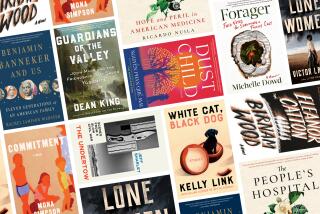DISCOVERIES
- Share via
Nature’s Beloved Son
Rediscovering John Muir’s Botanical Legacy
Bonnie J. Gisel with images by Stephen J. Joseph
Heyday Books: 248 pp., $45
Scotland, Wisconsin, Canada, Kentucky, Florida, Alaska and the Sierra Nevada; wherever he went, John Muir, first and foremost a botanist, carried a heavy plant press. These photographs of Muir’s herbarium, related notes, drawings and correspondence reveal the inner eye of the naturalist, his “sense of plants as spiritual beings.” “Nature,” he wrote, “one may fancy, amused at her own inventions. Nature’s purposes seen strikingly in seeds and buds, plans of another year of thousands of years, wrapped up in them.” In spite of their loss of color, the plants are vivid and intricate, accompanied by Muir’s impassioned handwriting and his careful, detailed drawings. The man was clearly driven, not just in his conservation efforts, but also in his desire to record and commemorate the beauty of plants.
Drafting Culture
A Social History of ‘Architectural Graphic Standards’
George Barnett Johnston
MIT Press: 286 pp., $39.95
There’s something luscious about these drawings of various types of chairs, and brickwork, plumbing fixtures, concrete tiles, library shelving, stacked shirts, stairs, university housing and on and on and on. They retrain the eye to notice the details and dimensions of our surroundings. The typography hearkens back to the 1930s and to the ethic of craftsmanship -- a time when we still lived in our bodies and not on our various screens. A time before the cult of personality swamped architecture, a time when the scale of things still mattered, the era of the drawing board: “[D]rafting culture has entered a new virtual realm of rules, operations, and discourse, stripped of the practical and pedagogical contexts that once defined its disciplinary core.”
Classical Chinese Poetry
An Anthology
translated and edited by David Hinton
Farrar, Straus & Giroux: 512 pp., $45
Three thousand years of poetry, from the first oral folk songs to the elegant simplicity of the mature written tradition. Chinese poetry, writes Hinton in his introduction, is graphic and physical, “an act of meditation,” “a perfectly empty mind mirroring the actual.” In this collection Hinton chose major poets from all walks of life as it was lived outside of the monastery by courtesans, shamans, peasants and farmers. “Seventh moon, Fire star ebbs away, / and ninth, we share our warm robes, / By the eleventh moon, chill winds howl, / and by the twelfth, it’s bitter cold, killing / cold, rough-quilt robes a blessing” -- from “Seventh Moon,” part of “The Book of Songs,” poems from the 12th to the 6th centuries BC, compiled by Confucius.
More to Read
Sign up for our Book Club newsletter
Get the latest news, events and more from the Los Angeles Times Book Club, and help us get L.A. reading and talking.
You may occasionally receive promotional content from the Los Angeles Times.









